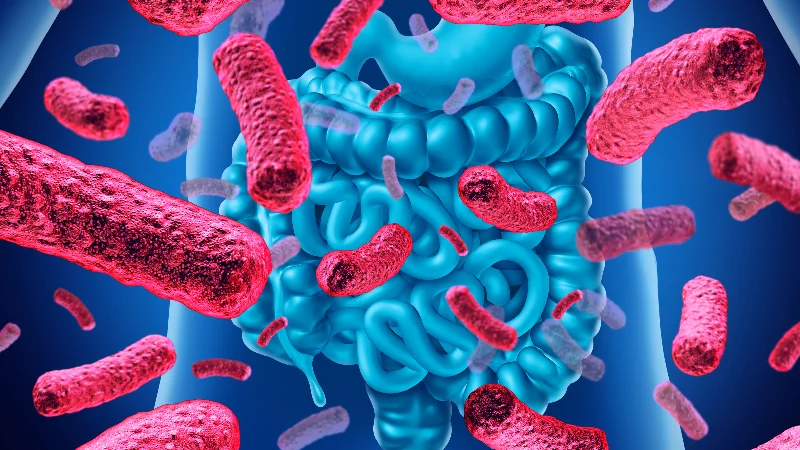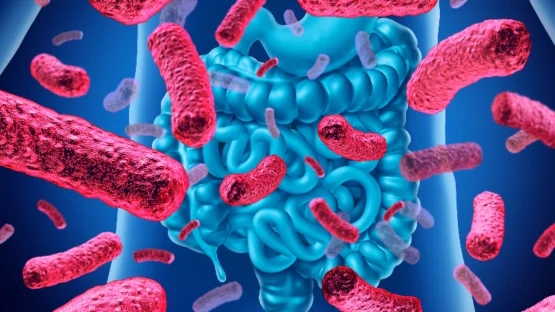Researcher Dr. Michael Lustgarten has recently published a compact and very readable review that focuses on the role of the gut microbiome and its influence on skeletal muscle mass.
The gut microbiome
The microbiome describes a varied community of bacteria, archaea, eukarya, and viruses that inhabit our gut. The four bacterial phyla of Firmicutes, Bacteroidetes, Proteobacteria, and Actinobacteria comprise 98% of the intestinal microbiome.
The microbiome community is a complex ecosystem whose activity regulates a number of functions in the gut and interacts with the immune system and energy metabolism. The beneficial bacteria in our gut also help to prevent the growth of harmful bacteria, protect us from invasive microorganisms, and help to maintain the integrity of the intestinal barrier.
One of the microbiome’s more important activities is to facilitate energy production and metabolic function, which it achieves by the creation of short-chain fatty acids (SCFAs) and their conjugate bases (acetate, propionate, and butyrate). A number of bacteria, including Faecalibacterium prausnitzii, Roseburia faecis, Anaerostipes butyraticus, Ruminococcaceae, and Christensenellaceae, break down fiber and ferment it to make these SCFAs, which are then used as an energy source for the microbiome and gut membrane cells such as colonocytes. This, in turn, supports the integrity of the intestinal barrier and stimulates the inflammasome pathway in gut homeostasis [1].
The gut microbiome helps facilitate immune function and development, and studies have shown that when the microbiome is absent, such as in animals kept in a sterile environment, the immune system does not develop and mature properly [2]. Gut bacteria such as Candida albicans and Citrobacter rodentium also help with pathogen control by activating T cells and summoning neutrophils and other immune cells. Bacteroides fragilis and Clostridium help to regulate inflammation by inducing the differentiation of regulatory T cells (FoxP3-positive) and the production of interleukin-10 and transforming growth factor β [3].
Reviewing the gut-muscle axis
This new review explores the link between the populations of bacteria in the gut with the age-related loss of skeletal muscle [4]. There is a particular focus on SCFAs during the review along with the excellent suggestion that more studies should include assessment of the presence of SCFAs, which play a vital role in providing the cells lining the intestine with energy and the decline of which may start a cascade that leads to leaky gut.
Within the past year, several studies have reported a positive role for the gut microbiome on the maintenance of skeletal muscle mass, evidence that contrasts previous reports of a negative role for the gut microbiome on the maintenance of whole body lean mass. The purpose of this mini-review is to clarify these seemingly discordant findings, and to review recently published studies that further elucidate the gut-muscle axis.
Conclusion
It is very clear that the health and diversity of our gut microbiome has a strong influence on a number of physiological systems and that adjusting the microbiome may be a useful therapeutic approach to improving health and, potentially, longevity.
Dr. Lustgarten also gave a talk at our Ending Age-Related Diseases 2019 conference in New York, which relates to this research as well as discusses biomarkers and optimal health.
For more info about Dr. Lustgarten and his work, head over to his blog, his university page, or his Twitter or Facebook pages.
Literature
[1] Macia, L., Tan, J., Vieira, A. T., Leach, K., Stanley, D., Luong, S., … & Binge, L. (2015). Metabolite-sensing receptors GPR43 and GPR109A facilitate dietary fibre-induced gut homeostasis through regulation of the inflammasome. Nature communications, 6, ncomms7734.
[2] L., & Mazmanian, S. K. (2009). The gut microbiota shapes intestinal immune responses during health and disease. Nature Reviews Immunology, 9(5), 313.
[3] Atarashi, K., Tanoue, T., Oshima, K., Suda, W., Nagano, Y., Nishikawa, H., … & Kim, S. (2013). T reg induction by a rationally selected mixture of Clostridia strains from the human microbiota. Nature, 500(7461), 232.
[4] Lustgarten, M. S. (2019). The role of the gut microbiome on skeletal muscle mass and physical function: 2019 update. Frontiers in Physiology, 10, 1435.




